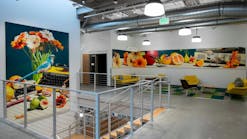LAST WORD | Increase service life of lighting products for greater overall benefit
From the initial lighting product design phase, circular economy principles can maximize the service life of luminaires, maintaining their materials' value for as long as possible via reuse and refurbishment. Beyond extending luminaire lifespan, embracing a circular economy model will result in less waste and less reliance on the extraction of raw materials, which will enable water and energy savings while supporting biodiversity. Lower emissions during the materials extraction, transportation, and manufacturing stages will lower overall greenhouse gas emissions and the accompanying climate impact.
With a few initial steps, manufacturers can ensure product circularity and maximize luminaire lifetime for customers, while increasing supply-chain stability and speed to market along the way.
Make it modular. Modular design is key to reusing components and having the ability to upgrade and repair products to extend service life. If common components are deployed across a product range, or across multiple ranges, then the likelihood of being able to reuse components increases. Take, for example, a surface-mount fixture installed in a retail space for several years. Perhaps a rebrand takes place and track spotlighting is now required. The existing fixtures can be remanufactured simply by replacing their surface-mounted canopy with a track adapter. Surface-mount components that have been removed are almost certainly reusable due to their durability; they can then be returned to the factory.
Modularity doesn’t end with the form factor, mount, or housing. Specifying optics, light sources, and drivers that can be upgraded or repaired extends the reuse of luminaire components. Typically, the power electronics and possibly the light sources will be the first components to fail within a luminaire. As a result, designs should ensure that those parts can be removed with ease via standard tools. Integrating multiple fixing points to the heatsink component can also facilitate LED and optics selections at the beginning and end of service life.
Simplify materials. Additional design tactics include reducing the number of required components and reviewing manufacturing processes to minimize material waste and volume; for instance, choose an extruded profile over one machined from a solid bar of material.
Using high-quality materials in the product manufacturing process can also significantly increase lifespan, as the former will resist degradation over time and perform better under various environmental conditions. For example, durable materials such as aluminum — with its high strength-to-weight ratio — can be anodized and powder-coated for greater resilience. Use recycled materials wherever possible and consider end-of-life recycling so materials can be repurposed into new product.
Stand by serviceability. Manufacturers should also provide a duty of care service beyond the standard manufacturer’s warranty to support products — and projects where they are installed — for the long term. Design and manufacture replacement parts in house whenever possible.
Manufacturers should also provide access to disassembly information via a unique identifier on a product, such as a serial number. Equip end users with resources on spare part listings, required tools, skill level information, and material identification, so the proper personnel can repair or upgrade a luminaire without returning it to the original manufacturer.
Luminaire manufacturers might consider a mobile repair and upgrade service for customers who cannot return large or bespoke fixtures, or in cases where the customer must minimize any facility closures, such as at a museum or gallery.
Increasing the service life of lighting products and advancing low-impact luminaires into the market requires a multifaceted approach. However, designing for durability, educating users, offering incentives, and engaging with the lighting community can enhance repeat business and drive sustainability goals into reality for the long term.
Interested in learning more? Download a white paper in which Stoane Lighting describes how it employed circular principles in designing a lighting product range.
RUAIRIDH MCGLYNN has 15 years of experience in the lighting industry, leading the specification support department at Stoane Lighting. McGlynn combines his product design and engineering expertise with a passion for sustainable and circular design, with particular interest in renewing existing products and design schemes. He also works as a photographer, documenting the impact of the climate crisis on the landscape.
Follow our LinkedIn page for our latest news updates, contributed articles, and commentary, and our Facebook page for events announcements and more. You can also find us on Twitter.





